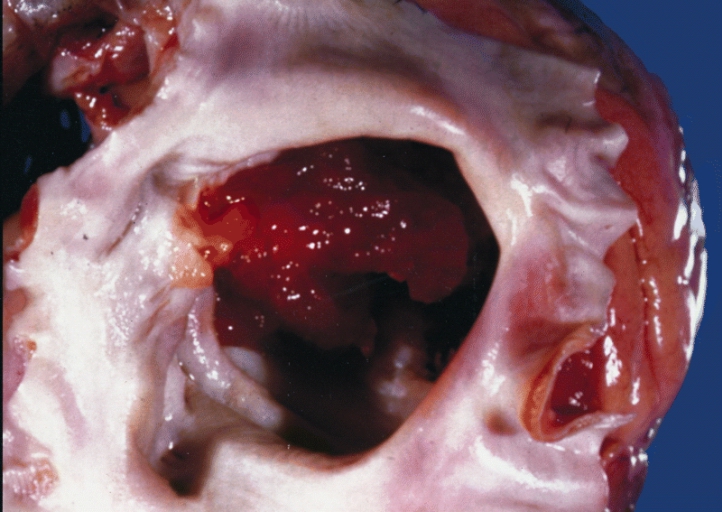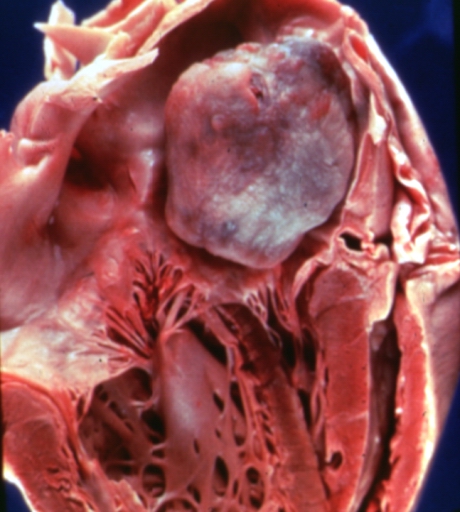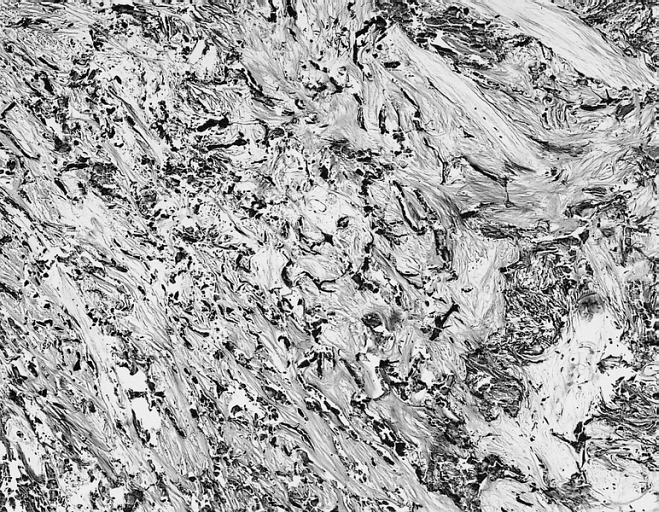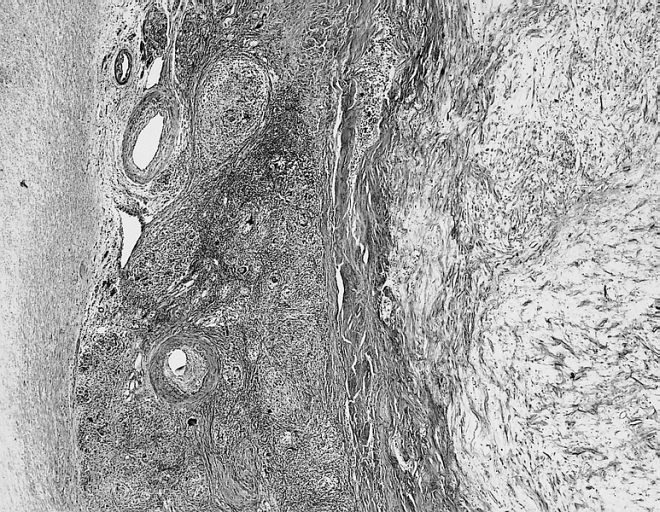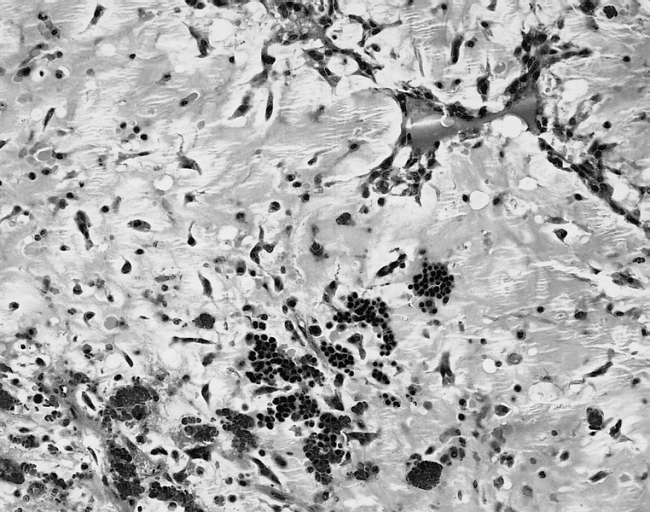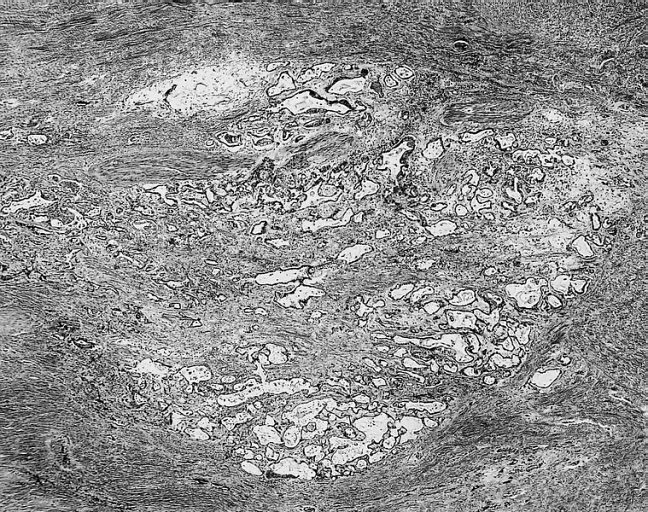Myxoma pathophysiology: Difference between revisions
No edit summary |
|||
| Line 1: | Line 1: | ||
__NOTOC__ | __NOTOC__ | ||
{{Myxoma}} | {{Myxoma}} | ||
{{CMG}} {{AE}} {{ | {{CMG}} {{AE}} {{MV}}{{CZ}}{{AAM}} | ||
==Overview== | ==Overview== | ||
| Line 7: | Line 7: | ||
==Pathophysiology== | ==Pathophysiology== | ||
Cardiac myxoma arises from | |||
Cardiac myxoma arises from remnants of subendocardial vasoformative reserve cells, which are primitive [[mesenchymal]] cells that are normally involved in the supportive structure of the [[endocardium]]. <ref name="pmid10064365">{{cite journal |vauthors=Roscher AA, Kato NS, Quan H, Padmanabhan M |title=Intra-atrial myxomas, clinical-pathologic correlation based on two case studies including historical review |journal=J Cardiovasc Surg (Torino) |volume=37 |issue=6 Suppl 1 |pages=131–7 |year=1996 |pmid=10064365 |doi= |url=}}</ref> <ref name="pmid11737312">{{cite journal |vauthors=Acebo E, Val-Bernal JF, Gómez-Román JJ |title=Prichard's structures of the fossa ovalis are not histogenetically related to cardiac myxoma |journal=Histopathology |volume=39 |issue=5 |pages=529–35 |year=2001 |pmid=11737312 |doi= |url=}}</ref> Myxomas are usually located in the [[fossa ovalis]] and [[endocardium]] of the [[atrial septum]]. | |||
===Gross Pathology=== | ===Gross Pathology=== | ||
On gross pathology, external appearance, consistency size and weight are extremely variable findings of cardiac myxoma | On gross pathology, external appearance, consistency size and weight are extremely variable findings of cardiac myxoma. Tumor consistency depends on the quantity and distribution of fibrous tissue and calcification (It can be smooth, lobulated, friable or gelatinous). <ref name="pmid25297937">{{cite journal |vauthors=Di Vito A, Mignogna C, Donato G |title=The mysterious pathways of cardiac myxomas: a review of histogenesis, pathogenesis and pathology |journal=Histopathology |volume=66 |issue=3 |pages=321–32 |year=2015 |pmid=25297937 |doi=10.1111/his.12531 |url=}}</ref> Usually a macroscopic gelatinous, irregular surface that fills the [[left atrium]] is a characteristic finding of myxoma. Myxomas that have irregular consistency are more likely to form surface thrombi and embolize. | ||
Morphologically, these lesions tend to be attached to the endocardium by a broad-based pedunculated stalk. In some cases, the attachment to the endocardium can also be without a clear stalk, or sessile. Cardiac myxomas are non-invasive tumors, thus there is no infiltration to underlying tissues. | |||
Cardiac myxomas are intracavitary tumors. The distribution is normally within the interatrial septum or adjacent to foramen ovale. However, they can also be found in other cardiac chambers, such as right atrium (15%),ventricles(˜2%)or cardiac valves (rare).<ref name="pmid12208428">{{cite journal |vauthors=Yoon DH, Roberts W |title=Sex distribution in cardiac myxomas |journal=Am. J. Cardiol. |volume=90 |issue=5 |pages=563–5 |year=2002 |pmid=12208428 |doi= |url=}}</ref> Large cardiac myxomas are usually located in [[fossa ovalis]].The average tumor size is from 0.6 to 12 cm, with a mean weight of 40 g.<ref name="pmid10903697">{{cite journal |vauthors=Grebenc ML, Rosado de Christenson ML, Burke AP, Green CE, Galvin JR |title=Primary cardiac and pericardial neoplasms: radiologic-pathologic correlation |journal=Radiographics |volume=20 |issue=4 |pages=1073–103; quiz 1110–1, 1112 |year=2000 |pmid=10903697 |doi=10.1148/radiographics.20.4.g00jl081073 |url=}}</ref> | |||
[http://www.peir.net Images shown below are courtesy of Professor Peter Anderson DVM PhD and published with permission © PEIR, University of Alabama at Birmingham, Department of Pathology] | [http://www.peir.net Images shown below are courtesy of Professor Peter Anderson DVM PhD and published with permission © PEIR, University of Alabama at Birmingham, Department of Pathology] | ||
Revision as of 15:30, 19 November 2015
|
Myxoma Microchapters |
|
Diagnosis |
|---|
|
Treatment |
|
Case Studies |
|
Myxoma pathophysiology On the Web |
|
American Roentgen Ray Society Images of Myxoma pathophysiology |
|
Risk calculators and risk factors for Myxoma pathophysiology |
Editor-In-Chief: C. Michael Gibson, M.S., M.D. [1] Associate Editor(s)-in-Chief: Maria Fernanda Villarreal, M.D. [2]Cafer Zorkun, M.D., Ph.D. [3]Ahmad Al Maradni, M.D. [4]
Overview
Cardiac myxoma contains undifferentiated mesenchymal cells, which potentially differentiate into many tissues such as blood vessels, glandular structures, bones, and source of extramedullary hematopoiesis.[1]
Pathophysiology
Cardiac myxoma arises from remnants of subendocardial vasoformative reserve cells, which are primitive mesenchymal cells that are normally involved in the supportive structure of the endocardium. [2] [3] Myxomas are usually located in the fossa ovalis and endocardium of the atrial septum.
Gross Pathology
On gross pathology, external appearance, consistency size and weight are extremely variable findings of cardiac myxoma. Tumor consistency depends on the quantity and distribution of fibrous tissue and calcification (It can be smooth, lobulated, friable or gelatinous). [4] Usually a macroscopic gelatinous, irregular surface that fills the left atrium is a characteristic finding of myxoma. Myxomas that have irregular consistency are more likely to form surface thrombi and embolize.
Morphologically, these lesions tend to be attached to the endocardium by a broad-based pedunculated stalk. In some cases, the attachment to the endocardium can also be without a clear stalk, or sessile. Cardiac myxomas are non-invasive tumors, thus there is no infiltration to underlying tissues.
Cardiac myxomas are intracavitary tumors. The distribution is normally within the interatrial septum or adjacent to foramen ovale. However, they can also be found in other cardiac chambers, such as right atrium (15%),ventricles(˜2%)or cardiac valves (rare).[5] Large cardiac myxomas are usually located in fossa ovalis.The average tumor size is from 0.6 to 12 cm, with a mean weight of 40 g.[6]
-
A gelatinous tumor is attached by a narrow pedicle to the atrial septum. The myxoma has an irregular surface and nearly fills the left atrium.
-
Left Atrial Myxoma
Microscopic Pathology
On microscopic histopathological analysis, Gamna-Bodies consist of fibrosis and deposition of iron pigments are characteristic findings of myxoma. Myxoma cells can be elongated, fusiform or stellate. They contain modest amounts of eosinophilic cytoplasm and have oval nuclei.
-
Cardiac Myxoma: Gamna Bodies: A peculiar form of fibrosis with deposition of iron pigment, identical to that seen in the spleens of patients with sickle cell anemia, is not uncommon in myxoma.
-
Cardiac Myxoma Common features at the interface with the atrial septum include lymphoid aggregates, smooth muscle bundles, and thick walled vessels which angiographically may look like neovascularization.
-
Cardiac Myxoma The extramedullary hematopoiesis seen here is present in about 7 percent of cardiac myxomas.
-
Cardiac Myxoma Glandular structures are seen in less than 5 percent of cases. In this example, they were limited to the base of the myxoma
References
- ↑ Bulkley BH, Hutchins GM (1979). "Atrial myxomas: a fifty year review". Am. Heart J. 97 (5): 639–43. PMID 433739.
- ↑ Roscher AA, Kato NS, Quan H, Padmanabhan M (1996). "Intra-atrial myxomas, clinical-pathologic correlation based on two case studies including historical review". J Cardiovasc Surg (Torino). 37 (6 Suppl 1): 131–7. PMID 10064365.
- ↑ Acebo E, Val-Bernal JF, Gómez-Román JJ (2001). "Prichard's structures of the fossa ovalis are not histogenetically related to cardiac myxoma". Histopathology. 39 (5): 529–35. PMID 11737312.
- ↑ Di Vito A, Mignogna C, Donato G (2015). "The mysterious pathways of cardiac myxomas: a review of histogenesis, pathogenesis and pathology". Histopathology. 66 (3): 321–32. doi:10.1111/his.12531. PMID 25297937.
- ↑ Yoon DH, Roberts W (2002). "Sex distribution in cardiac myxomas". Am. J. Cardiol. 90 (5): 563–5. PMID 12208428.
- ↑ Grebenc ML, Rosado de Christenson ML, Burke AP, Green CE, Galvin JR (2000). "Primary cardiac and pericardial neoplasms: radiologic-pathologic correlation". Radiographics. 20 (4): 1073–103, quiz 1110–1, 1112. doi:10.1148/radiographics.20.4.g00jl081073. PMID 10903697.
